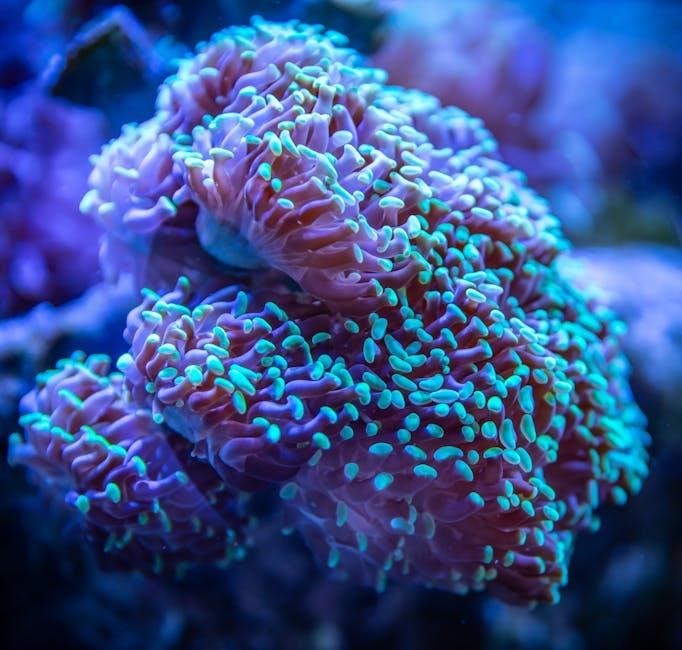What Is Life? A Guide to Biology with Physiology is a comprehensive guide that connects biology to everyday life, using real-world examples and interactive tools like Achieve to engage students.
1.1 Overview of the Book and Its Purpose
What Is Life? A Guide to Biology with Physiology is designed to help students understand the relevance of biology in their daily lives. It emphasizes real-world applications, encouraging readers to think scientifically and explore how biology influences their decisions and experiences. The book’s purpose is to provide a clear, engaging introduction to biology, making complex concepts accessible through storytelling and practical examples. By integrating interactive tools like Achieve, it offers a comprehensive learning experience, combining lectures, labs, and simulations to prepare students for confident scientific discussions. This approach ensures that learners not only grasp biological principles but also develop a deeper appreciation for life’s intricacies and their role within the natural world.
1.2 The Author: Jay Phelan and His Contributions to Biology Education
Jay Phelan is a renowned educator and biologist, teaching at UCLA’s Life Sciences Core Program since 1997. Specializing in evolutionary biology, human behavior, and genetics, Phelan is dedicated to making complex scientific concepts engaging and accessible. His work emphasizes storytelling and real-world examples, fostering curiosity and critical thinking in students. With What Is Life?, he has created a resource that not only educates but also inspires students to explore biology’s role in their lives. Phelan’s innovative approach and commitment to student engagement have made him a respected figure in biology education, ensuring that his work continues to influence future generations of scientists and thinkers.

The Structure and Content of the Book
What Is Life? integrates engaging storytelling with interactive tools like Achieve All-in-One, offering comprehensive coverage of biology and physiology through dynamic simulations and real-world applications.
2.1 Key Themes and Topics Covered
What Is Life? A Guide to Biology with Physiology delves into core biological concepts, including cellular biology, genetics, evolution, and human physiology. It explores how these topics intersect with daily life, emphasizing practical applications and fostering curiosity. The book also covers current advancements in genetics and biotechnology, providing a modern perspective on scientific discoveries. By integrating real-world examples, it helps students appreciate biology’s relevance in health, environment, and technology. Additionally, the text incorporates interactive tools like Achieve All-in-One, which offers simulations to enhance understanding of complex biological processes. This comprehensive approach ensures students gain both foundational knowledge and the ability to engage confidently in scientific discussions.
2.2 Unique Features of the Book, Including Achieve All-in-One Lecture & Lab Simulations
The book stands out for its integration with Achieve All-in-One, a cutting-edge online platform that combines lecture materials, lab simulations, and personalized study tools. This feature allows students to engage with biology in an interactive and immersive way, enhancing their understanding of complex concepts. The simulations provide hands-on experiences, enabling students to explore biological processes virtually. Additionally, the book incorporates storytelling techniques and real-world examples to make learning more relatable and engaging. These unique features, combined with Jay Phelan’s clear and accessible writing style, make the book an exceptional resource for both majors and non-majors seeking to understand biology’s relevance in their lives.

The Role of Biology in Daily Life
Biology shapes daily decisions and experiences, influencing health, nutrition, and environmental interactions. It fosters scientific thinking and curiosity, helping individuals understand the world around them.
3.1 How Biology Influences Everyday Decisions and Experiences
Biology plays a pivotal role in shaping daily decisions, from dietary choices to health practices. Understanding biological processes, such as digestion or immune function, informs personal wellness strategies. Additionally, biology influences environmental decisions, like conservation efforts, by highlighting the interconnectedness of ecosystems. The study of biology also fosters curiosity and critical thinking, encouraging individuals to question and explore the natural world. By applying biological principles, people can make informed choices about their lifestyles, relationships, and interactions with the environment. This integration of biology into daily life empowers individuals to navigate the world more thoughtfully and responsibly.

3.2 Encouraging Scientific Thinking and Curiosity
What Is Life? A Guide to Biology with Physiology fosters scientific thinking by encouraging students to ask questions and explore the natural world. By presenting biology as a dynamic and accessible field, the book sparks curiosity and motivates learners to engage with scientific concepts. Interactive tools like Achieve All-in-One Lecture & Lab Simulations provide hands-on experiences, making complex ideas relatable and fun. Jay Phelan’s storytelling approach and real-world examples further inspire students to think critically about how biology impacts their lives. This approach not only builds scientific literacy but also empowers students to view the world with a sense of wonder and inquiry, preparing them to navigate life’s challenges with confidence and intellectual curiosity.
Physiology and Its Importance in Understanding Life
Physiology reveals how living organisms function, from human systems to adaptations in other species, essential for understanding life’s complexity and interconnectedness.
4.1 Human Physiology: Systems and Functions
Human Physiology: Systems and Functions delves into the intricate mechanisms of the human body, exploring how systems like the circulatory, respiratory, and nervous systems interact to maintain life. This section explains the roles of organs and tissues, emphasizing how they work together to regulate bodily functions. By understanding these processes, readers gain insights into how lifestyle choices impact health and disease. The text uses real-world examples and interactive tools, such as Achieve All-in-One, to make complex physiological concepts accessible. This approach fosters a deeper appreciation for the human body’s efficiency and resilience, while also highlighting the importance of maintaining balance within its systems.
4.2 Comparative Physiology: How Different Organisms Adapt to Their Environments
Comparative Physiology investigates how diverse organisms adapt to their environments, showcasing the remarkable variability of life. From desert plants with water-conserving mechanisms to marine organisms thriving in saltwater, each adaptation reflects evolutionary ingenuity. For instance, polar species have developed antifreeze proteins to survive freezing temperatures, while tropical organisms optimize their metabolism for high heat. These adaptations highlight the intricate relationships between physiology and ecology, demonstrating how life persists in even the most extreme conditions. By studying these comparisons, readers gain a deeper understanding of the universal principles of biology and the extraordinary diversity of life on Earth. This section underscores the importance of physiological adaptations in ensuring survival across varied ecosystems.
The Educational Approach of Jay Phelan
Jay Phelan employs an engaging and interactive approach in What Is Life?, using storytelling, real-world examples, and tools like Achieve to make biology accessible and inspiring for students.
5.1 Engaging Students Through Storytelling and Real-World Examples
Jay Phelan captivates students by weaving biology into compelling narratives, making complex concepts relatable. He uses real-world examples and current events to illustrate how biology impacts daily life. By connecting scientific principles to personal experiences, Phelan fosters curiosity and critical thinking. His storytelling approach transforms abstract ideas into tangible scenarios, encouraging students to see biology as a dynamic, ever-evolving field. Additionally, the book integrates interactive tools like Achieve, which offers simulations and assessments to deepen understanding. This method not only enhances learning but also prepares students to engage confidently in scientific discussions, bridging the gap between theory and application.

5.2 Preparing Students to Discuss Science Confidently
Jay Phelan empowers students to articulate scientific concepts with clarity and assurance. Through engaging narratives and real-world examples, the book builds a foundation for confident communication. Phelan’s approach encourages students to think critically and express their understanding effectively. The text’s emphasis on practical applications and relatable scenarios helps learners connect biology to their own lives, fostering a sense of ownership over the material. Achieve, an innovative online tool, further supports this by providing interactive simulations and assessments. These resources enable students to engage deeply with the content, preparing them to discuss science confidently in various settings, from academic discussions to everyday conversations.

